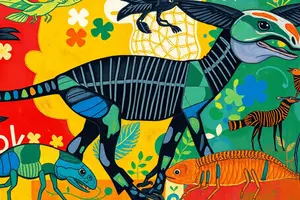Podcast
Questions and Answers
The animal kingdom is divided into what two major groups?
The animal kingdom is divided into what two major groups?
- Mammals and Reptiles
- Fish and Birds
- Invertebrates and Vertebrates (correct)
- Amphibians and Fishes
What is a vertebrate?
What is a vertebrate?
An animal with a backbone.
What is an invertebrate?
What is an invertebrate?
An animal without a backbone.
Which has the largest number of animal species?
Which has the largest number of animal species?
What is the process of grouping things together by a set of rules called?
What is the process of grouping things together by a set of rules called?
Name the five classes that make up the animal kingdom of vertebrates.
Name the five classes that make up the animal kingdom of vertebrates.
Name the characteristics of amphibians.
Name the characteristics of amphibians.
Name the characteristics of birds.
Name the characteristics of birds.
Name the characteristics of fish.
Name the characteristics of fish.
Name the characteristics of mammals.
Name the characteristics of mammals.
What part of the fish allows it to breathe in water?
What part of the fish allows it to breathe in water?
What is a backbone?
What is a backbone?
In what other way can animals be classified besides by their Phylum?
In what other way can animals be classified besides by their Phylum?
How does a cold-blooded animal maintain its body temperature?
How does a cold-blooded animal maintain its body temperature?
Is a starfish a vertebrate or invertebrate?
Is a starfish a vertebrate or invertebrate?
Is an octopus a vertebrate or invertebrate?
Is an octopus a vertebrate or invertebrate?
Is a jellyfish a vertebrate or invertebrate?
Is a jellyfish a vertebrate or invertebrate?
Is a shark a vertebrate or invertebrate?
Is a shark a vertebrate or invertebrate?
Is a crab a vertebrate or invertebrate?
Is a crab a vertebrate or invertebrate?
Is a whale a vertebrate or invertebrate?
Is a whale a vertebrate or invertebrate?
Is a newt a vertebrate or invertebrate?
Is a newt a vertebrate or invertebrate?
Is a snake a vertebrate or invertebrate?
Is a snake a vertebrate or invertebrate?
Is an eagle a vertebrate or invertebrate?
Is an eagle a vertebrate or invertebrate?
Is a turtle a vertebrate or invertebrate?
Is a turtle a vertebrate or invertebrate?
If an animal has feathers, to what class group does it belong?
If an animal has feathers, to what class group does it belong?
Name the animal class groups that are cold-blooded.
Name the animal class groups that are cold-blooded.
Name the animal class groups that are warm-blooded.
Name the animal class groups that are warm-blooded.
What two animal classes have scales?
What two animal classes have scales?
What animal class groups can be found near water?
What animal class groups can be found near water?
What class group is born in water but as adults leave the water to live on land?
What class group is born in water but as adults leave the water to live on land?
What class group feeds their young milk from the female's body?
What class group feeds their young milk from the female's body?
Which class groups mostly lay eggs?
Which class groups mostly lay eggs?
How do fish breathe?
How do fish breathe?
Flashcards are hidden until you start studying
Study Notes
Animal Kingdom Classification
- The animal kingdom is divided into two main groups: invertebrates (no backbone) and vertebrates (with backbone).
- Invertebrates contain the largest number of species within the animal kingdom.
Definitions
- Vertebrate: An animal with a backbone.
- Invertebrate: An animal without a backbone.
- Classification: The process of organizing organisms by a specific set of rules.
Groups of Vertebrates
- Vertebrates are categorized into five classes:
- Amphibians: Moist skin, no scales, begin life in water, most adults live on land, undergo metamorphosis.
- Fish: Covered in scales, use gills for breathing, live entirely in water.
- Reptiles: Scaly skin, mostly lay eggs, cold-blooded.
- Mammals: Have hair, produce milk for young through mammary glands, typically give live births.
- Birds: Covered in feathers, adaptations for flight, usually lay eggs.
Characteristics of Classes
- Amphibians: Require water for development, begin life aquatic, adults often terrestrial.
- Birds: Feathers provide insulation and enable flight.
- Fish: Gills for underwater respiration, scales for protection.
- Mammals: Hair for warmth, mammary glands for feeding young.
- Cold-blooded Animals: Maintain body temperature based on environmental conditions.
- Warm-blooded Animals: Maintain a constant body temperature regardless of the environment.
Additional Classification Insights
- Animals can also be classified as cold-blooded (amphibians, reptiles, fish) or warm-blooded (birds, mammals).
- Fish and reptiles are identified by having scales.
Habitats and Adaptations
- All animal classes depend on water for survival in various ways—amphibians start life in water, fish live in water, and some mammals and birds hunt or swim in aquatic environments.
- Amphibians exemplify a class that begins life in water but transitions to land as adults.
Breathing Mechanisms
- Fish breathe using gills, which allow them to extract oxygen from water.
- Backbone consists of a series of bones linked by cartilage, providing structural support.
Verification of Vertebrate vs Invertebrate
- Examples of invertebrates: starfish, octopus, jellyfish, crab.
- Examples of vertebrates: shark, whale, newt, snake, eagle, turtle.
- Invertebrates lack a backbone, while vertebrates possess one.
Reproductive Strategies
- Classes laying largely eggs: birds, amphibians, fish, and reptiles.
- Mammals uniquely provide nourishment through breast milk, a defining characteristic.
Studying That Suits You
Use AI to generate personalized quizzes and flashcards to suit your learning preferences.




